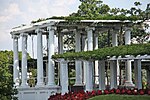Civil War Unknowns Monument
1865 establishments in VirginiaAmerican Civil War military monuments and memorialsArlington National CemeteryBuildings and structures completed in 1865Monuments and memorials in Virginia ... and 1 more
Tombs of Unknown Soldiers

The Civil War Unknowns Monument is a burial vault and memorial honoring unidentified dead from the American Civil War. It is located in the grounds of Arlington House, The Robert E. Lee Memorial, at Arlington National Cemetery in Arlington, Virginia, in the United States. It was designed by Quartermaster General Montgomery C. Meigs and constructed in 1865. Many sources often incorrectly state that the monument was constructed in the middle of the Lee flower garden (often mischaracterized as a "rose garden"). However, the monument is just west of the flower garden, in what was once a grove of oak and elm trees.
Excerpt from the Wikipedia article Civil War Unknowns Monument (License: CC BY-SA 3.0, Authors, Images).Civil War Unknowns Monument
Lee Avenue, Arlington Courthouse
Geographical coordinates (GPS) Address External links Nearby Places Show on map
Geographical coordinates (GPS)
| Latitude | Longitude |
|---|---|
| N 38.880416 ° | E -77.073183 ° |
Address
Civil War Unknowns Monument
Lee Avenue
22211 Arlington, Courthouse
Virginia, United States
Open on Google Maps









